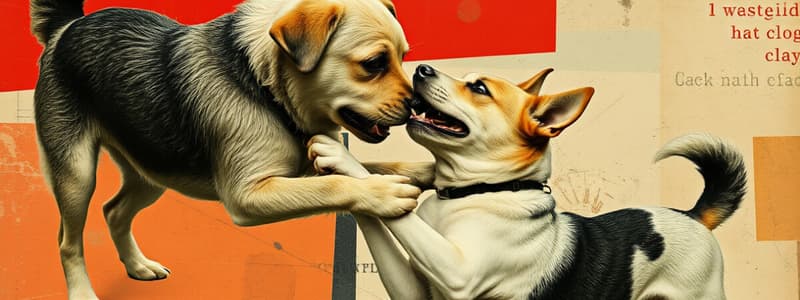Podcast
Questions and Answers
What indicates that play is intended to be fun and not serious among dogs?
What indicates that play is intended to be fun and not serious among dogs?
- Excessive biting and aggressive chasing
- Maintaining a strict posture during interactions
- Ritualistic behaviors like play bows or pawing the air (correct)
- Ignoring other dogs during play
In social play, what lesson do dogs learn from biting each other playfully?
In social play, what lesson do dogs learn from biting each other playfully?
- To enhance their hunting skills
- To inhibit their bite if they want to continue playing (correct)
- To avoid social interactions in the future
- To establish dominance over the other dog
Which type of play involves behaviors like mounting and pelvic thrusting?
Which type of play involves behaviors like mounting and pelvic thrusting?
- Sexual Play (correct)
- Social Play
- Playful Wrestling
- Oral Play
What might happen if the pressure of a pup's bite exceeds tolerable limits during social play?
What might happen if the pressure of a pup's bite exceeds tolerable limits during social play?
What is the primary purpose of play for dogs?
What is the primary purpose of play for dogs?
What key lesson do puppies learn from adult dogs?
What key lesson do puppies learn from adult dogs?
Why are off-leash parks not recommended for puppies?
Why are off-leash parks not recommended for puppies?
What should be ensured before enrolling a dog in daycare?
What should be ensured before enrolling a dog in daycare?
What indicates potentially dangerous behavior in play between dogs?
What indicates potentially dangerous behavior in play between dogs?
How should appropriate play between dogs generally look?
How should appropriate play between dogs generally look?
What characterizes Polite Players in dog play?
What characterizes Polite Players in dog play?
Which play style involves significant physical contact among dogs?
Which play style involves significant physical contact among dogs?
What do dogs typically do in the 'Chase or Be Chased' play style?
What do dogs typically do in the 'Chase or Be Chased' play style?
In Mouth Wrestlers play, what is a common position for one dog?
In Mouth Wrestlers play, what is a common position for one dog?
What happens in the Freeze Tag play style?
What happens in the Freeze Tag play style?
What important skills do puppies learn during play?
What important skills do puppies learn during play?
What does the Puppy Prime Directive suggest?
What does the Puppy Prime Directive suggest?
What behavior might be observed in puppies early on during play?
What behavior might be observed in puppies early on during play?
What might indicate that play is becoming too rough between dogs?
What might indicate that play is becoming too rough between dogs?
What is a possible consequence of breaking play rules for puppies?
What is a possible consequence of breaking play rules for puppies?
What is a sign of inappropriate play between two dogs?
What is a sign of inappropriate play between two dogs?
How do puppies typically respond after a short disagreement during play?
How do puppies typically respond after a short disagreement during play?
What is the best practice for meeting two dogs on leash?
What is the best practice for meeting two dogs on leash?
What action should be taken if dogs seem overly excited during play?
What action should be taken if dogs seem overly excited during play?
Why is it important to keep the leash loose during dog introductions?
Why is it important to keep the leash loose during dog introductions?
What is the definition of 'non-aligned' body orientation in dogs?
What is the definition of 'non-aligned' body orientation in dogs?
Which behavior indicates healthy communication between dogs during interactions?
Which behavior indicates healthy communication between dogs during interactions?
What does the term 'tandem behaviors' refer to in dog interactions?
What does the term 'tandem behaviors' refer to in dog interactions?
Why are slow interactions important in dog meetings?
Why are slow interactions important in dog meetings?
What is self-interruption in dog interactions?
What is self-interruption in dog interactions?
Which behavior is NOT a common self-interruption behavior in dogs?
Which behavior is NOT a common self-interruption behavior in dogs?
What is a key indicator that dogs are socialized properly?
What is a key indicator that dogs are socialized properly?
What does it mean when dogs exhibit aligned body orientation?
What does it mean when dogs exhibit aligned body orientation?
What behavior indicates that a dog may be out of control or intent on harm?
What behavior indicates that a dog may be out of control or intent on harm?
What does it indicate when a dog's body weight is forward?
What does it indicate when a dog's body weight is forward?
What is one effective method for interrupting escalating puppy play?
What is one effective method for interrupting escalating puppy play?
What should be done if water spraying does not interrupt a dog's inappropriate behavior?
What should be done if water spraying does not interrupt a dog's inappropriate behavior?
When is using a 'clicking' sound recommended?
When is using a 'clicking' sound recommended?
What behavior is described as visible incisor exposure during barking?
What behavior is described as visible incisor exposure during barking?
What is a concern when interrupting play among adult dogs?
What is a concern when interrupting play among adult dogs?
What should be evaluated if play levels are constantly high?
What should be evaluated if play levels are constantly high?
What behaviour indicates a potential escalation of problems in dogs?
What behaviour indicates a potential escalation of problems in dogs?
Which response is a sign to be particularly cautious during dog interactions?
Which response is a sign to be particularly cautious during dog interactions?
What does 'rude interactions' in dogs refer to?
What does 'rude interactions' in dogs refer to?
What is the primary reason for not reaching into a dog fight?
What is the primary reason for not reaching into a dog fight?
What is indicated by a 'call' with a delayed answer?
What is indicated by a 'call' with a delayed answer?
Which method involves spraying water directly onto the dogs?
Which method involves spraying water directly onto the dogs?
What does a frontal and aligned body orientation signify?
What does a frontal and aligned body orientation signify?
When should the shaker can technique be used?
When should the shaker can technique be used?
In what way can fast interactions between dogs be problematic?
In what way can fast interactions between dogs be problematic?
Why is it recommended to use a fake, stuffed dog during behavior assessments?
Why is it recommended to use a fake, stuffed dog during behavior assessments?
What is an indicator that a dog fight is not serious?
What is an indicator that a dog fight is not serious?
Which interruption method should be used if the fight is escalating?
Which interruption method should be used if the fight is escalating?
What does sustained direct eye contact combined with frontal orientation typically indicate?
What does sustained direct eye contact combined with frontal orientation typically indicate?
What is a common injury sustained during dog fights?
What is a common injury sustained during dog fights?
What should you do if you are not comfortable breaking up a fight?
What should you do if you are not comfortable breaking up a fight?
What is the correct response if a direct spray of air does not work?
What is the correct response if a direct spray of air does not work?
What is the most likely description of dogs in Levels 1 and 2?
What is the most likely description of dogs in Levels 1 and 2?
What is essential for dogs at Level 3?
What is essential for dogs at Level 3?
What should be done with a Level 4 dog regarding its living situation?
What should be done with a Level 4 dog regarding its living situation?
What prognosis is associated with Level 5 and Level 6 dogs?
What prognosis is associated with Level 5 and Level 6 dogs?
What type of play do German Shepherds typically exhibit?
What type of play do German Shepherds typically exhibit?
What should be done if a Level 4 dog is taken from the house?
What should be done if a Level 4 dog is taken from the house?
What is a common characteristic of Level 1 and Level 2 dogs?
What is a common characteristic of Level 1 and Level 2 dogs?
What technique is recommended for training during Levels 1 and 2?
What technique is recommended for training during Levels 1 and 2?
What is advised for owners of a Level 4 dog regarding their responsibility?
What is advised for owners of a Level 4 dog regarding their responsibility?
What should be avoided when training dogs at all levels?
What should be avoided when training dogs at all levels?
What is the primary benefit of predatory play for dogs?
What is the primary benefit of predatory play for dogs?
Which of the following best defines bite inhibition in dogs?
Which of the following best defines bite inhibition in dogs?
Which scenario would most likely indicate a Level 3 bite on the bite assessment scale?
Which scenario would most likely indicate a Level 3 bite on the bite assessment scale?
What could dogs resort to if they are deprived of play predatory opportunities?
What could dogs resort to if they are deprived of play predatory opportunities?
What does a Level 4 bite on the bite assessment scale indicate?
What does a Level 4 bite on the bite assessment scale indicate?
How is the severity of a dog's biting behavior assessed?
How is the severity of a dog's biting behavior assessed?
What is an important consideration before dog-to-dog introductions?
What is an important consideration before dog-to-dog introductions?
What may result from a Level 6 bite on the bite assessment scale?
What may result from a Level 6 bite on the bite assessment scale?
Flashcards are hidden until you start studying
Study Notes
Understanding Play
- Play is a fun, pleasurable activity that mimics serious behaviors like fighting or hunting, but without any real intention.
- Dogs exhibit a range of playful behaviors including running, jumping, wrestling, and humping, typically initiated with a play invitation.
- Calm signals such as play bows indicate a desire to engage in fun without serious intent.
Types of Play
- Social Play: Helps puppies develop social skills through interactions that teach bite inhibition and deference.
- Sexual Play: Characterized by mounting and thrusting behaviors, often without a serious intent and can involve various targets.
- Predatory Play: Involves chasing moving objects (like balls and sticks) to refine predatory skills and energy release.
Bite Inhibition
- Defined as a dog's ability to control bite pressure to prevent serious harm.
- Bite incidents are assessed on a scale (Levels 1 to 6) ranging from uncaptured aggressive behavior to fatal attacks, with most incidents falling within Levels 1 and 2.
Play Styles
- Vary among dogs, influencing interaction success; incompatible play styles can lead to misunderstandings.
- Polite Players: Gentle and respectful, they adjust play styles based on other dogs’ body language.
- Rough Players: Engage in intense physical play with forceful contact, common in bully breeds.
- Chase/Be Chased: Dogs initiate chasing games to encourage running and excitement.
- Mouth Wrestlers: Involves playful biting and mouthing focused on neck areas.
Puppy Play
- Facilitates social and behavioral learning, with puppies often exhibiting exaggerated, socially inappropriate behaviors.
- Adult dogs teach puppies boundaries and rules of play, which change around 16-20 weeks of age.
Interaction Environments
- Off-Leash Parks: Not recommended for puppies due to bullying risks.
- Daycares: Should only be utilized if staff knows canine behavior and can manage play based on personality.
Understanding Play Dynamics
- Healthy play includes activities like parallel running, pouncing, and gentle contact; all dogs should willingly participate.
- Signs of inappropriate play include excessive mouthing on sensitive areas or unrelenting dominance.
On-Leash Interactions
- Best approached with relaxed behaviors and a loose leash; initial greeting should involve polite sniffing.
- Slow, calm introductions help ease tension and allow for better communication.
Social Communication in Dogs
- Healthy interactions show non-aligned body positioning, two-way communication, and tandem behaviors.
- Self-interruption indicates a dog’s ability to recognize social cues and enhance interactions.
Red Flags and Warning Signs
- Observe direct eye contact, frontal body orientations, and rude interactions as potential red flags for escalating behaviors.
- Continuous high arousal or unself-interrupted attention can signal danger or aggression.
General Observations
- Routine gaps or breaks in action suggest healthy play, while incessant energy without breaks may necessitate separation.
- Proper guidance during introductions and play can mitigate risks and promote enjoyable experiences for all dogs involved.### Interrupting Inappropriate Play
- Puppy and dog play requires monitoring to maintain a fun environment for all participants.
- Continuous interruptions or high arousal levels indicate the need to reassess the play group, potentially shortening playtime or forming smaller groups.
- Use treats to lure an 'offending' puppy away for a timeout; this method works for adult dogs but requires caution due to potential aggression over food.
- A clicking or smooching sound can effectively interrupt play during peak arousal.
- More intense behaviors like freezing, prolonged gripping, or bullying can be interrupted with a water spray in the face of the offending dog.
- If water sprays fail after two attempts, evaluate the appropriateness of the play partners.
- For serious situations or skirmishes, tools like a shaker can or compressed air can be used as a last resort, but not as first responses unless a fight occurs.
Breaking Up Fights
- Dog fights should be handled carefully; direct intervention can lead to personal injury.
- Walk away if unsure of how to break up a fight and seek help; redirected bites pose a risk.
- Noisy fights are generally ritualized with lower injury risks, whereas quiet fights are serious and require immediate intervention.
- Proper tools should be in place for dog introductions where the dogs are unfamiliar with each other.
- Effective methods for interrupting behavior or breaking up fights include:
- Water (bucket or hose): Spray directly onto fighting dogs' faces until they separate.
- Shaker can: Shake a tin can filled with coins or rocks above the dogs to create a startling noise.
- Air horn/Direct stop: Spray towards the dogs' faces; do not repeat if ineffective on the first try.
- Banging bowls: Create loud noises to startle the dogs, similar to the shaker can method.
- Wheelbarrow technique: If all else fails, lift the hind legs of the instigating dog to separate them, ideally with the help of another person for effectiveness.
Studying That Suits You
Use AI to generate personalized quizzes and flashcards to suit your learning preferences.




